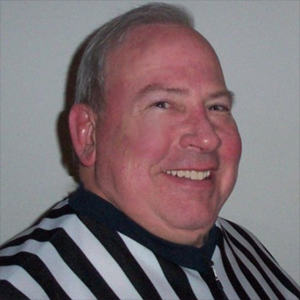
Rndballref
20 Years Experience
Chicago, IL
Male, 60
For twenty years I officiated high school, AAU and park district basketball games, retiring recently. For a few officiating is the focus of their occupation, while for most working as an umpire or basketball referee is an avocation. I started ref'ing to earn beer money during college, but it became a great way to stay connected to the best sports game in the universe. As a spinoff, I wrote a sports-thriller novel loosely based on my referee experiences titled, Advantage Disadvantage
Some international games are played without referees touching the ball on violations, as you suggest. I guess it rewards readiness but also creates a sneakiness to the game. As it is played in high school federation rules, the referees should hold the ball allowing substitutes and the teams are given time to setup. I suppose it is a matter of preference.
A try or tap ends when it is apparent that the ball will not go through the ring. So when a 3 point try falls short and the ball bounces on the floor the try is over. When a ball enters the ring and goes through (assuming it is no longer a 3 point try) it is a two point score.
Pro, college men, college women and high school rules sometime are different so I'm only addressing high school rules.I believe this situation was addressed in a recent case book for the NFHS (national federation of high schools). As I recall, the case book interpretation was that playing with too many players was punishable ONLY if discovered during a live ball. As you have described it, I believe the technical foul was called in error. Furthermore, strong referees would always count players after substitutes come in and/or after timeouts, especially at the varsity level with a three man crew. Preventive officiating would have at least one of the crew always count the players. You will notice this watching a seasoned good crew, as the official administering the throw-in, free throws, or jump ball will look for visual confirmation from his partners, who would be responsible for counting players. Sounds like you were jobbed.
Most respectful way is to ask the ref if he can discuss a play. If you are the kind of coach who is shilling for every call you will be ignored by a skilled official for your own good. You would do well to expend your enegy in understanding how tight or loose a ref is calling a game, and coaching accordingly, rather than ratcheting up your complaints. During a game, the ref holds all the cards. After the game if you feel a ref is grossly misinterpreting the rules talk to the assignment chairman.
Personal Stylist & Life Coach
 What makes someone qualified to life-coach someone else?
What makes someone qualified to life-coach someone else?
HR Executive
 What's the worst reaction you ever witnessed during a lay-off?
What's the worst reaction you ever witnessed during a lay-off?
3D Games Developer/Programmer
 Is the new Oculus Rift thing as cool as everyone says?
Is the new Oculus Rift thing as cool as everyone says?
The ball is dead when it is apparent to the referee that it will not hit the rim or enter the ring. I wouldn't think that any reasonable official would whistle a lane violation, ruling that it occurred before the free throw was dead. I have never seen it, and if one of my partners called that it would seem like he is trying to pick a fight or punish one team. The only exception would be if the other team steps into the lane (well before the shot is launched) to purposely disconcert the free thrower and he fires an air ball, then I suppose a violation could be called.
Replay IS being used by various levels in basketball. In National Federation of High School Rules, states are allowed the option to use replay in the state tournament for specific things such as whether a buzzer shot was launched before time expired. In college, they use replay to ascertain the severity of fouls - whether a tech foul is flagarant or class 1, etc. NBA seems to use it more. The benefit is to make sure you get the call correct, the obvious downside is that it takes time and breaks momentum.
Based on your scenario this should not have been called a "T". Remember it is a technical foul to have more than 5 players on the floor DURING A LIVE BALL. In your description the ball never changed status to live because on a throw in the ball is only considered live when "it is put at the disposal of the team who will execute the throw in". Your ref made an error.
-OR-
 Login with Facebook
Login with Facebook (max 20 characters - letters, numbers, and underscores only. Note that your username is private, and you have the option to choose an alias when asking questions or hosting a Q&A.)
(A valid e-mail address is required. Your e-mail will not be shared with anyone.)
(min 5 characters)
By checking this box, you acknowledge that you have read and agree to Jobstr.com’s Terms and Privacy Policy.
-OR-
 Register with Facebook
Register with Facebook(Don't worry: you'll be able to choose an alias when asking questions or hosting a Q&A.)